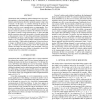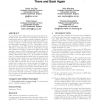115 search results - page 3 / 23 » Compressed text indexes: From theory to practice |
ICIP
2004
IEEE
14 years 9 months ago
2004
IEEE
Quantization index modulation (QIM) techniques have been gaining popularity in the data hiding community because of their robustness and information-theoretic optimality against a...
SPIRE
2007
Springer
14 years 1 months ago
2007
Springer
Abstract. A compressed full-text self-index for a text T is a data structure requiring reduced space and able of searching for patterns P in T. Furthermore, the structure can repro...
CIKM
2008
Springer
13 years 9 months ago
2008
Springer
Inverted indexes using sequences of characters (n-grams) as terms provide an error-resilient and language-independent way to query for arbitrary substrings and perform approximate...
WWW
2005
ACM
14 years 8 months ago
2005
ACM
On an abstract level, XML Schema increases the limited expressive power of Document Type Definitions (DTDs) by extending them with a recursive typing mechanism. However, an invest...
DCC
2008
IEEE
14 years 7 months ago
2008
IEEE
Semistatic word-based byte-oriented compression codes are known to be attractive alternatives to compress natural language texts. With compression ratios around 30%, they allow di...


